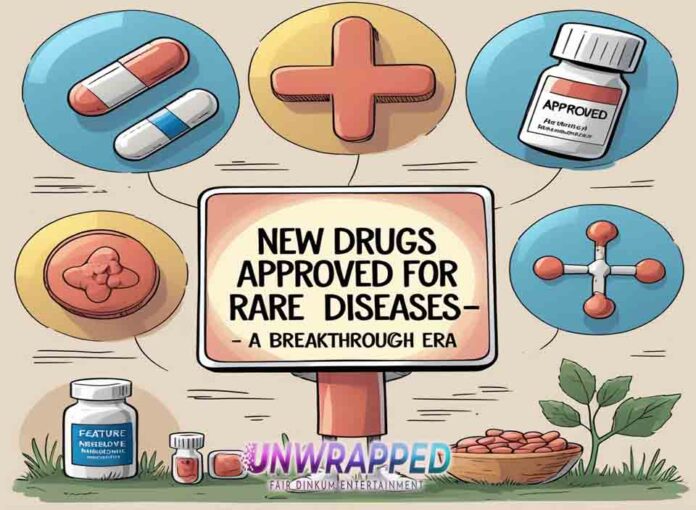In the last few years, the medical world has entered a new era of hope for patients living with rare diseases—those conditions affecting fewer than 200,000 individuals in the U.S., or similarly small populations globally. These illnesses were long considered “untreatable” simply because the economics and logistics of drug development made them unviable. But thanks to regulatory reforms, innovative technologies like gene therapy, and greater collaboration among researchers, recent approvals of new drugs for rare diseases are rewriting that narrative.
From mitochondrial disorders to ultra-rare genetic syndromes, these approvals matter—not just technically but emotionally—for patients and families who, for decades, may have had no options. The U.S. Food & Drug Administration (FDA) reports that in 2024, more than half of novel drug approvals addressed rare or orphan diseases.
Understanding Rare Diseases and Orphan Designation
What defines a rare disease?
A rare disease is typically defined in the U.S. as one affecting fewer than 200,000 people; in Europe the threshold is often fewer than 1 in 2,000 individuals. These conditions often involve complex genetics, multisystem involvement and high unmet medical need. The U.S. Orphan Drug Act of 1983 created incentives—such as seven years of market exclusivity and tax credits—to encourage development of treatments for these conditions.
Why have approvals for rare-disease treatments accelerated lately?
Several factors have combined to boost the pipeline:
Regulatory flexibility: The FDA’s Rare Disease Innovation Hub and the Rare Disease Evidence-Development Program (RDEP) allow alternative trial designs, use of biomarkers and approvals based on smaller patient numbers.
Technological advances: Gene therapies, RNA interference and precision medicine make targeting rare diseases more feasible than ever.
Market viability: As companies realise that high-impact orphan drugs can be commercially sustainable, investment in this area has grown.
Patient advocacy and data tools: Better registries, natural-history studies and patient-group collaboration have reduced evidence gaps.
According to a review, drugs for non-oncology rare diseases now account for a growing share of annual novel approvals.
See Also: 10 Best Medical Apps for Monitoring Health in 2025
Notable Recent Approvals – Examples of Progress
For zinity (Elamipretide) for Barth Syndrome
On September 19, 2025, the FDA granted accelerated approval to Forzinity (elamipretide), marking the first therapy for Barth syndrome, a life-threatening mitochondrial disorder. Patients (weighing at least 30 kg) with this condition now have their first treatment option. This milestone underscores the power of regulatory flexibility in ultra-rare diseases.
Ctexli (Chenodeoxycholic acid) for Cerebrotendinous Xanthomatosis (CTX)
In February 2025, the FDA approved Ctexli for Cerebrotendinous xanthomatosis (CTX), a rare cholesterol-metabolism disorder previously lacking any approved treatment. The drug, an oral form of chenodeoxycholic acid, offers a concrete example of how long-neglected conditions can finally gain specific therapies.
Amvuttra (Vutrisiran) for ATTR-CM
On March 20, 2025, the FDA expanded the indication of Amvuttra (vutrisiran) — initially approved for nerve damage in transthyretin amyloidosis — to now include the rare heart disease Transthyretin amyloid cardiomyopathy (ATTR-CM). This approval illustrates how rare-disease drugs can evolve beyond narrow original uses to broader patient impact.
Trends and Insights Impacting Rare-Disease Drug Development
Growing proportion of orphan approvals
The FDA reports that 52 % of novel drug approvals in 2024 targeted rare diseases. Other analyses highlight that non-oncology rare-disease approvals continue to rise year to year.
Use of accelerated pathways, biomarkers and real-world evidence
The RDEP and other programs allow for approval based on fewer or smaller studies, particularly in contexts where patient numbers are extremely limited. This shift makes previously untenable development program feasible.
Gene- and cell-based therapies are gaining steam
While traditional small-molecule therapies remain important, the frontier for ultra-rare genetic conditions is moving toward gene therapy and in vivo delivery mechanisms.
Repurposing of existing drugs
Drug-repurposing—identifying new uses for approved compounds—continues to offer efficiencies in rare-disease development, reducing risk and cost.
Challenges That Remain
Access and affordability
Even after approval, rare-disease drugs often face steep price tags and complex reimbursement barriers. For instance, the approved price of Amvuttra is reported at ~US$119,351 per prefilled syringe. Ensuring equitable access remains a major challenge.
Evidence gaps and long-term safety
Because trials often include small numbers of patients or use surrogate endpoints, post-marketing surveillance becomes critical. Regulatory guidance has strengthened focus on withdrawal criteria if effectiveness is not upheld.
Global uptake and regulatory variability
While the U.S. regulatory path may be equipped for rapid rare-disease approvals, other jurisdictions may lag—creating global inequities in availability.
Diagnoses and patient identification
Many rare diseases remain undiagnosed or misdiagnosed, limiting the potential reach of new therapies. Natural-history studies and patient registries are still under-resourced in many regions.
What This Means for Patients, Clinicians and Health-Systems
For patients and families
New approvals bring hope: For the first time ever, therapies are available for diseases like CTX or Barth syndrome.
Shared decision-making becomes more important: Families must weigh benefits, risks and costs carefully.
True access may require advocacy: Patient-organisations and clinicians will increasingly need to help navigate reimbursement hurdles.
Another Must-Read: Top Reasons Medical Students Fail to Qualify as Surgeons
For clinicians
Staying informed is critical: Rare-disease approvals are progressing quickly and may impact disease-management strategies.
Collaboration with specialist centres is key: Many therapies require highly specialised care or monitoring.
Longterm follow-up matters: Even after approval, monitoring for safety and effectiveness is essential.
For health-systems and payers
Value frameworks must adapt: Traditional cost-effectiveness models struggle to capture benefits in ultra-rare diseases.
Early dialogue and horizon-scanning are vital: Systems must anticipate and prepare for high-cost therapies.
Equity challenges loom: Governments and payers must work to ensure newer therapies don’t widen gaps in care.
Call to Action
If you found this overview helpful, share it with patient-communities, health-professionals or anyone interested in the rare-disease field—and comment below with any specific condition or therapy you’d like to see covered next. For ongoing updates on new rare-disease drug approvals, subscribe to our site and stay ahead of the innovation curve.
Conclusion
The landscape for drugs approved for rare diseases is transforming—fast. What was once a field of unmet need with little hopeful news is now a dynamic domain of breakthroughs, regulatory innovation and growing patient-impact. Therapies like Forzinity for Barth syndrome and Ctexli for CTX exemplify the real-world progress being made.
Yet the journey is far from over. Ensuring that these treatments translate into access, affordability and global equity remains paramount. For patients, families and cross-discipline stakeholders, the momentum is real—and the promise of more to come is deeply inspiring.
People Also Love: Fake Medical Cures: Why Influencers Are Under Fire










